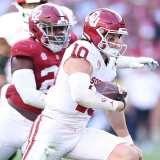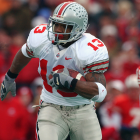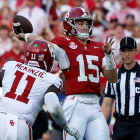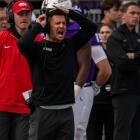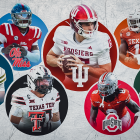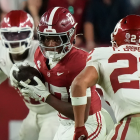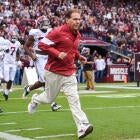
'Don't be in a rush': Maurice Clarett's advice to Jeremiah Smith as Ohio State freshman rises to superstardom
Clarett knows better than anyone the pressures of standing out in college football as a superstar freshman

In a parallel universe, Maurice Clarett was Jeremiah Smith. Different position, different eras, different lives but shared experiences at the same age with similar talent and upside.
One -- Clarett -- is a faded memory to some, a 40-year-old former Buckeye whose one-and-done career at Ohio State was known as much for its off-field shame as its football excellence.
The other -- Smith -- is a former No. 1 overall recruit who has hijacked the sport the same way he has fleeced balls from defensive backs this season. Smith has become the second-leading receiver in the Big Ten with his one-handed catches vaulting him into the Heisman Trophy conversation.
Oh, to be 18 again.
Both stormed the gates of college football convention in their freshman seasons.
The former great and budding star cross paths every Tuesday. Clarett is the friendly former Ohio State running back sensation who visits the facility one day a week to help any way he can -- speaking with coaches, counseling players, etc.
Some players know his story. Some don't. It's been that long.
"It's like you're warning somebody against something that can and will happen, but they don't believe it can and will happen to them," Clarett said.
So all he can do is teach, advise and warn.
It's been 22 years since Clarett came out of Youngstown, Ohio, to help the Buckeyes win the 2002 national championship before flaming out before our eyes. There were academic issues. The NCAA came sniffing around. Finally, Ohio State kicked him off the team in 2003.
Today, Clarett is a successful entrepreneur having long ago pulled himself out of the depths of scandal. It seemed like a good time to ask his thoughts about Smith, who shares the same attributes, future and potential that Clarett once did.
"We're talking about the same school," Clarett said. "But we're not talking about the same program."
In 2002, those were the "Luckeyes," who won seven of their 14 games by a touchdown or less. Clarett and a stingy defense were the centerpieces. Things seem more complicated in 2024, however, with NIL, the transfer portal and realignment.
Ohio State has long since established itself as Wide Receiver U. The program went all in this season in an attempt to snap a three-game losing streak to rival Michigan, win the Big Ten and make a College Football Playoff run -- in that order.
Smith may be the key to the whole thing. The Big Ten Freshman of the Week might be the Big Ten Player of the Year. Against Michigan State last week, he had 83 yards receiving and 19 rushing. The pair of one-handed catches against the Spartans blew up the internet.
TWO UNBELIEVEABLE ONE-HANDED CATCHES BY JEREMIAH SMITH 🤯
— SportsCenter (@SportsCenter) September 29, 2024
THEY CAN'T GUARD HIM 👀 pic.twitter.com/vGUUs6rn41
"When you're talking about Ohio State now, you're talking about the lineage of Garrett Wilson, Chris Olave, Marvin Harrison Jr. and a series of other first-round picks," Clarett said.
"Look at [wide receivers coach] Brian Hartline. He played in the NFL, coached in the NFL," he added. "Brian has had all the success with the receivers. The kids coming in and having success, it's very easy for a kid to have success … you're already buying in."
Their connection across the decades starts with ability and timing. Both entered their freshman seasons at Ohio State at the tender age of 18. Both quickly proved they could play in the NFL at the same age.
Both were swallowed up by the sport's hype machine. Clarett -- rather his football reputation -- never came out alive. He first got sideways with Ohio State when he wasn't allowed to travel back from the Fiesta Bowl to attend a friend's funeral. Things cratered from there. Clarett ended his college career with one season in which he ran for 1,237 yards and 16 touchdowns despite missing three games.
Upon leaving, Clarett challenged the NFL's rule requiring college players to wait three years to turn pro. He eventually came up short in that bid. Clarett actually won his challenge to the NFL's early entry rule in 2003 at the district court level -- for a hot minute. The decision was quickly overturned on appeal in the circuit court by who is now current Supreme Court judge Sonia Sotomayor.
Smith would never think of such a thing today. He's busy challenging defensive backs for contested catches. So far, Smith is winning -- big.
"Just like the rest of the world, when you first heard of him, you heard of all the potential," Clarett said. "I've been in that position.
"The only difference between myself and him, you can tell what has taken place before he got here; he's been prepped," Clarett said.
For football and for life.
It's no secret Smith's cousin is Seahawks QB Geno Smith. A huge NIL deal is assumed. Ohio State athletic director Ross Bjork remains the only credible source on NIL payments, admitting during the offseason that the program spent $20 million on this season's roster.
"I had good people giving me advice," Clarett said. "I just didn't listen to it. These kids are literally making millions of dollars. This is just a different day and age. You weren't thinking you would one day make millions of dollars. It wasn't the same situation."
The intent of this interview was to get Clarett to weigh in on a subject only he and handful are qualified to do. What NIL is today would have landed players back then in NCAA jail.
"For the most part these kids don't know my story," Clarett said. "To me it serves more as a distraction if you lead with it."
So he doesn't. Besides, there would be no motivation for Smith these days to test the NFL rule given the current NIL climate. He can live comfortably for three seasons -- at least -- at Ohio State.
"Sometimes in your mind it sounds noble to want to do something to be a trailblazer," Clarett said. "It just ain't worth it."
"When these kids come in now they're not worried about what they have to do financially," he added.
And, for the most part, athletes in the Wild West era of NIL have conducted themselves well. There are exceptions, but the foundations of the game are still the same. No matter how much money you make, you still have work has hard as everyone else in the locker room. If not, we know the NFL is watching.
And any posing upsets the delicate fabric that holds a locker room together.
None of those great, former Ohio State receivers mentioned above started as a freshman like Smith. The kid was one of 10 Ohio State players given "Iron Buckeye" status by the strength coaches. Smith is believed to be the first freshman to earn that label.
"[Smith is] in a completely different space," Clarett said. "I was laughing with somebody yesterday. I've lived long enough to be kicked out of school on one hand. And [I've] lived long enough to come to see it come to pass. This is what this [NIL] stuff was made for."
Smith's 6-foot-3, 215-pound body looks like it is too good for college at times. But that 18-year-old body would be filled out and worth more in two years prior to the 2027 NFL Draft. NIL has basically muted the discussion over the three-year rule.
With that $20 million in "payroll" at their disposal, players like Smith will be more than comfortable financially as they work on their game.
These days, the faded star with the wisdom collected over the decades has a piece of advice that resonates beyond those Tuesdays.
"Hey man, don't be in a rush," Clarett said.




